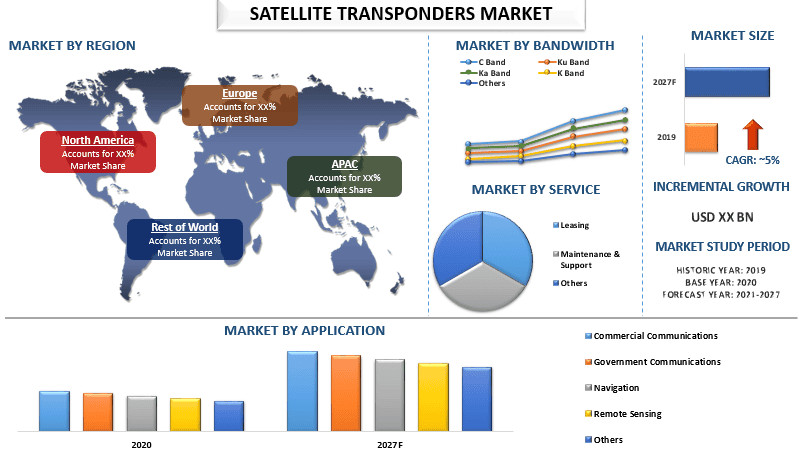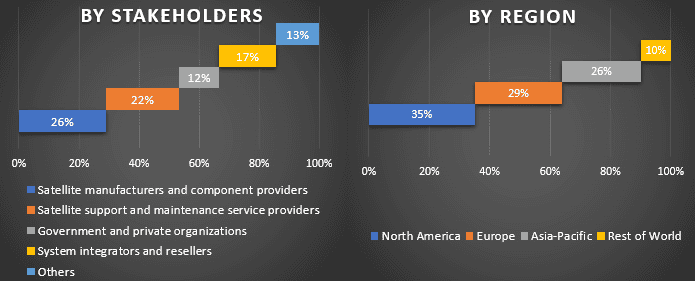
衛星トランスポンダ市場は2020年に約190億米ドル規模であり、予測期間中に約5%のCAGRで成長すると予想されます.衛星トランスポンダ市場の成長に影響を与える主な要因は、新しいテレビプラットフォームとテクノロジーに対する需要の増加、KuバンドおよびKaバンドサービスの成長、および高いデータ転送速度に対する需要の増加です。ほとんどの先進国および発展途上国でテレビの視聴時間が増加しているため、新しいテレビプラットフォームとテクノロジーの需要が増加しています。したがって、衛星およびトランスポンダの需要に影響を与えています。さらに、Kuバンドは一般的にビデオ、データ、音声通信に使用されます。また、Kaバンド周波数の採用が増加しており、高帯域幅のブロードキャストおよび通信目的にも広く利用されています。したがって、衛星トランスポンダ市場の成長にプラスの影響を与えています。
レポートに提示された洞察
「帯域幅のうち、Cバンドカテゴリーが2020年に顕著な市場シェアを占めた」
帯域幅に基づくと、市場はCバンド、Kuバンド、Kaバンド、Kバンド、およびその他に分類されます。2020年には、Cバンド帯域幅が世界の衛星トランスポンダ市場の大きなシェアを占めました。このセグメントの収益成長は、不安定な気候や環境条件による接続の中断の可能性が低い、包括的で十分な接続容量が必要なため、企業オフィスや大学におけるCバンドの実装の増加によって牽引されています。
「サービスのうち、リーシングカテゴリーが市場でかなりのシェアを占めた」
サービスに基づいて、市場はリーシング、メンテナンスとサポート、およびその他に分類されます。これらのうち、リーシングが世界の衛星トランスポンダ市場で顕著なシェアを占めており、予測期間中に強い成長シェアを目撃すると予想されます。世界中でインターネットが出現したことで、ブロードバンドは地球上のすべての人にとって不可欠な情報源となっています。したがって、通信業界は、地球上で最も接続されていない場所にブロードバンド設備を提供するために、より多くのトランスポンダをリースすることを積極的に検討しています。さらに、インターネットユーザーとビデオ放送加入者の増加も、衛星トランスポンダリーシング市場を牽引しています。さらに、ほとんどの民間および公共メディア組織は、放送市場での成長機会のために、トランスポンダリース期間を延長するための長期契約を承認しました。
「APACは予測期間中に著しい成長を示す可能性が高い」
APACは、予測期間中に顕著なCAGRを示すと予想されます。この地域でのスマートフォンユーザーの増加は、その手頃な価格のために、より良い通信接続に対する需要の増加につながっています。さらに、DTHサービスの需要増加、標準画質から高画質への置き換え、軍事および防衛のための安全な通信の必要性、およびこの地域の大規模な放送業界が理由として挙げられます。これにより、中国やインドなどの発展途上国も衛星技術に注力し、宇宙および衛星セクターへの投資を増やさざるを得なくなっています。さらに、APAC地域のさまざまな国の政府が、民間企業に宇宙セクターを開放して衛星を開発させ、ビジネスの拡大を支援するためのいくつかのイニシアチブが、投資を顕著に増加させており、市場収益の成長を促進すると予想されています。
市場で活動している主要なプレーヤーには、SES S.A.、The Arab Satellite Communications Organization、Eutelsat Communications S.A.、Intelsat S.A.、Embratel Star One、Thaicom Public Company Limited、Sky Group Limited、Singapore Telecommunications Limited、Telesat Corporation、Hispasat S.A.などが含まれます。
このレポートを購入する理由:
- この調査には、認証された主要業界専門家によって検証された市場規模と予測分析が含まれています
- このレポートは、業界全体のパフォーマンスを簡単にレビューできます
- このレポートは、主要なビジネス財務、製品ポートフォリオ、拡張戦略、および最近の動向に焦点を当てて、著名な業界ピアの詳細な分析をカバーしています
- 業界で蔓延するドライバー、制約、主要なトレンド、および機会の詳細な検討
- この調査は、さまざまなセグメントにわたる市場を包括的にカバーしています
- 業界の詳細な国レベル分析
カスタマイズオプション:
世界の衛星トランスポンダ市場は、要件またはその他の市場セグメントごとにさらにカスタマイズできます。これに加えて、UMIは、お客様が独自のビジネスニーズを持っている可能性があることを理解しており、お客様の要件に完全に合ったレポートを入手するために、お気軽にご連絡ください。
目次
世界の衛星トランスポンダ市場分析(2019-2027年)の調査方法
過去の市場を分析し、現在の市場を推定し、衛星トランスポンダの将来の市場を予測するために、世界中の採用状況を作成および分析するために3つの主要なステップが実施されます。過去の市場規模を収集し、現在の市場規模を推定するために、徹底的な二次調査が実施されました。次に、これらの洞察を検証するために、多数の調査結果と仮定が考慮されました。さらに、衛星トランスポンダ業界のバリューチェーン全体にわたる業界専門家との徹底的な一次面接も実施されました。一次面接による市場規模の仮定と検証後、ボトムアップアプローチを採用して、完全な市場規模を予測しました。その後、市場の細分化とデータの三角測量方法を採用して、関連する業界のセグメントとサブセグメントの市場規模を推定および分析しました。詳細な方法論を以下に説明します。
過去の市場規模の分析
ステップ1:二次情報源の詳細な調査:
衛星トランスポンダの過去の市場規模を取得するために、次のような社内情報源を使用して詳細な二次調査を実施しました。年次報告書と財務諸表、業績プレゼンテーション、プレスリリースなど、および以下を含む外部ソースジャーナル、ニュースと記事、政府出版物、競合他社の出版物、セクターレポート、サードパーティデータベース、およびその他の信頼できる出版物。
ステップ2:市場セグメンテーション:
衛星トランスポンダ市場の過去の市場規模を取得した後、主要地域におけるさまざまなセグメントとサブセグメントの現在の市場洞察とシェアを収集するために詳細な二次分析を実施しました。主なセグメントは、帯域幅、サービス、および用途別にレポートに含まれています。さらに、世界的な衛星トランスポンダの採用を評価するために、地域別および国レベルの分析が実施されました。
ステップ3:要因分析:
さまざまなセグメントとサブセグメントの過去の市場規模を取得した後、詳細な要因分析を実施して、衛星トランスポンダの現在の市場規模を推定しました。さらに、大量のデータを高速で処理する能力とデジタル化など、従属変数と独立変数を使用して要因分析を実施しました。衛星トランスポンダ業界における投資の増加、トップパートナーシップ、合併と買収、事業拡大、および製品発売を考慮して、需要と供給側のシナリオの詳細な分析が実施されました。
現在の市場規模の推定と予測
現在の市場規模のサイジング:上記の3つのステップからの実用的な洞察に基づいて、現在の市場規模、世界の衛星トランスポンダ市場の主要プレーヤー、および各セグメントの市場シェアに到達しました。必要なすべてのパーセンテージシェア分割と市場内訳は、上記のように二次アプローチを使用して決定され、一次面接を通じて検証されました。
推定と予測:市場の推定と予測のために、ドライバーとトレンド、制約、および利害関係者が利用できる機会など、さまざまな要因に重みが割り当てられました。これらの要因を分析した後、関連する予測手法、つまりボトムアップアプローチを適用して、世界中の主要地域にわたるさまざまなセグメントとサブセグメントについて2027年までの市場予測に到達しました。市場規模を推定するために採用された調査方法には以下が含まれます。
- 主要市場における衛星トランスポンダの価値(米ドル)と採用率の面での業界の市場規模
- 市場セグメントとサブセグメントのすべてのパーセンテージシェア、分割、および内訳
- 衛星トランスポンダ市場の主要プレーヤー。また、これらのプレーヤーが急成長市場で競合するために採用した成長戦略。
市場規模とシェアの検証
一次調査:主要地域全体で、主要なオピニオンリーダー(KOL)との詳細なインタビューを実施しました。これには、トップレベルの幹部(CXO / VP、セールスヘッド、マーケティングヘッド、オペレーションヘッド、リージョナルヘッド、カントリーヘッドなど)が含まれます。一次調査の結果を要約し、統計分析を実施して、述べられた仮説を証明しました。一次調査からのインプットは二次調査の結果と統合され、情報を実用的な洞察に変換しました。
利害関係者別および地域別の一次参加者の分割

市場エンジニアリング
データ三角測量技術を採用し、グローバル衛星トランスポンダ市場の各セグメントおよびサブセグメントの正確な統計数値を導き出すために、全体的な市場推定を完了しました。データは、帯域幅、サービス、およびアプリケーションの分野におけるさまざまなパラメータとトレンドを調査した後、いくつかのセグメントとサブセグメントに分割されました。
衛星トランスポンダ市場調査の主な目的
グローバル衛星トランスポンダの現在および将来の市場動向を調査で特定しました。投資家は、調査で実施された定性的および定量的分析に基づいて、投資に関する裁量権の基礎となる戦略的洞察を得ることができます。現在および将来の市場動向は、国レベルでの市場全体の魅力を決定し、産業参加者が未開拓市場を活かしてファーストムーバーの利点を得るためのプラットフォームを提供します。調査のその他の定量的目標には、以下が含まれます。
- 衛星トランスポンダの現在の市場規模と予測市場規模を金額(米ドル)で分析します。また、さまざまなセグメントとサブセグメントの現在の市場規模と予測市場規模を分析します
- 調査のセグメントには、帯域幅、サービス、およびアプリケーションの分野が含まれます
- 衛星トランスポンダ業界の規制枠組みの定義された分析
- さまざまな仲介業者の存在に関連するバリューチェーンを分析し、業界の顧客と競合他社の行動を分析します
- 主要国の衛星トランスポンダの現在の市場規模と予測市場規模を分析します
- レポートで分析された主要な地域/国には、北米(米国、カナダ、北米のその他)、ヨーロッパ(ドイツ、英国、フランス、イタリア、スペイン、ヨーロッパのその他)、アジア太平洋(中国、日本、インド、オーストラリア、アジア太平洋のその他)、および世界のその他が含まれます
- 衛星トランスポンダ市場プレーヤーの企業プロファイルと、成長市場で持続するための成長戦略
- 業界の詳細な国レベル分析
関連 レポート
この商品を購入したお客様はこれも購入しました










